Mr Monkey found out that there was a tour of underground Manchester, and he thought it would be a really good idea to go on it.
He made sure he was waiting outside Oxford Road Station at the right time, and joined the large crowd of people intent on learning about Underground Manchester. The guide, Ed, led the party down to an alley off Great Marlborough Street; in the 1820s and 1830s this was 'Little Ireland', where thousands of immigrant Irish workers lived in cellars.
Next the tour crossed Whitworth Street and stopped above the route of the Guardian Exchange tunnel, which was built as a hiding place for the Lord Mayor and other worthies at the beginning of the Cold War when a limited nuclear exchange seemed a relatively sensible way of dealing with international disputes. There's about 4 miles of tunnel down there, but it's used by BT and access is restricted.
Ed led the tour along the Rochdale Canal to Lock 89, where he stopped to talk about the Rochdale Canal which crossed Manchester and linked with other canals to allow freight to cross the country.
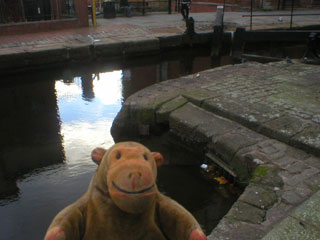
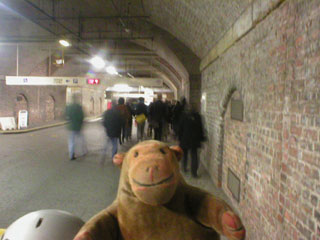
A rather small drain takes excess water from the canal into the river Tib, which is culverted under the city. Mr Monkey had a quick look, but there wasn't any excess water to be drained.
Next Ed told the group about the Manchester and Salford Junction Canal.
This was a section of canal which opened in 1839 to connect the Rochdale Canal to the river Irwell, so that goods could be transferred from the canal to the river without being taken across Manchester on wagons. It was about half a mile long and had 4 locks descending a total of 40 feet.
The party followed the Manchester and Salford Junction canal to the Bridgewater Hall, then followed its route through the carpark under the Manchester Central complex. The eastern end of the canal, between Lower Moseley Street and Watson Street, was filled in when Central Station was built, though Cheshire Lines had originally planned to build the station over the canal. Leaving the carpark Ed led Mr Monkey to the Great Northern.
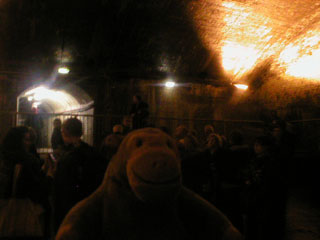
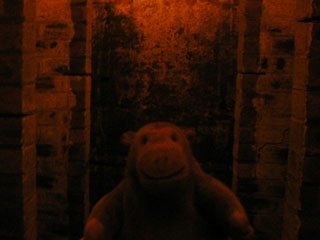
Inside the Great Northern, Ed took the group into a small room full of architectural models of the development. Mr Monkey had no time to look at the models, because he had to scamper through an ordinary looking door and down a metal staircase to discover the secrets beneath the Great Northern.
After the building of Central Station the remaining canal, from Watson Street to the Irwell, was used to give warehouses access to the river.
The canal was closed in 1936, but was left intact under the Great Northern Warehouse.
In 1939 the city authorities realised that they'd need air raid shelters in the centre of Manchester, and decided to convert a 1600 foot long section of the underground canal into an air raid shelter theoretically adequate for 5000 people. The canal was drained, blast walls were built every 100 feet to limit the damage caused if a bomb should hit the shelter, toilets of some sort were installed, staircases to the surface were built and helpful signs were put up.
Ed showed the group the main features of the tunnels and then told everyone they could wander about freely, provided they were careful.
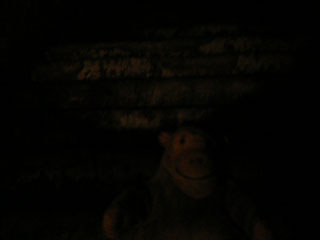
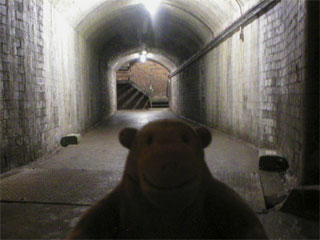
Mr Monkey had a fine time wandering around the accessible parts of the shelter. One of the bays had some lights laid on; in the other four Mr Monkey was glad his humans had remembered to bring torches with them.
He examined the sturdy walls built to contain the blast from bombs. He marvelled at the ladder leading down from a manhole on the surface (apparently urban explorers use it to get in). He inspected the cubicles intended for toilets, the bricked up stairs to the surface and the lift shafts that used to take goods from the transhipment dock up to the warehouse.
He walked in and out of rudimentary rooms built for unknown purposes, and was very careful to keep clear of the water in the flooded area. If he'd been foolish enough to go into the flooded area he could have been carried by a wading human all the way to the Granada Studios, but doing that isn't totally legal.
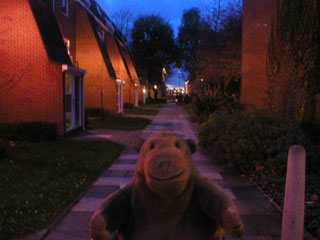
When he'd had his fill of the underground, Mr Monkey rejoined the rest of the group and left the Great Northern. They crossed Deansgate and walked along Camp Street to the gardens that used to be St John's churchyard. Camp Street broadly follows the route of the Manchester Salford Junction canal.
Looking over the hedge at the park which has been made out of the churchyard Mr Monkey learned about the scandal of St. John's and its dodgy burial practices (which involved not leaving all the bodies where they'd been buried). When the tour was done, Mr Monkey decided against going further down Camp Street to peer over the walls over Granada Studios and set off for home instead.



 A rather small drain takes excess water from the canal into the river Tib, which is culverted under the city. Mr Monkey had a quick look, but there wasn't any excess water to be drained.
A rather small drain takes excess water from the canal into the river Tib, which is culverted under the city. Mr Monkey had a quick look, but there wasn't any excess water to be drained.

 Inside the Great Northern, Ed took the group into a small room full of architectural models of the development. Mr Monkey had no time to look at the models, because he had to scamper through an ordinary looking door and down a metal staircase to discover the secrets beneath the Great Northern.
Inside the Great Northern, Ed took the group into a small room full of architectural models of the development. Mr Monkey had no time to look at the models, because he had to scamper through an ordinary looking door and down a metal staircase to discover the secrets beneath the Great Northern.
 Mr Monkey had a fine time wandering around the accessible parts of the shelter. One of the bays had some lights laid on; in the other four Mr Monkey was glad his humans had remembered to bring torches with them.
Mr Monkey had a fine time wandering around the accessible parts of the shelter. One of the bays had some lights laid on; in the other four Mr Monkey was glad his humans had remembered to bring torches with them.
 When he'd had his fill of the underground, Mr Monkey rejoined the rest of the group and left the Great Northern. They crossed Deansgate and walked along Camp Street to the gardens that used to be St John's churchyard. Camp Street broadly follows the route of the Manchester Salford Junction canal.
When he'd had his fill of the underground, Mr Monkey rejoined the rest of the group and left the Great Northern. They crossed Deansgate and walked along Camp Street to the gardens that used to be St John's churchyard. Camp Street broadly follows the route of the Manchester Salford Junction canal.